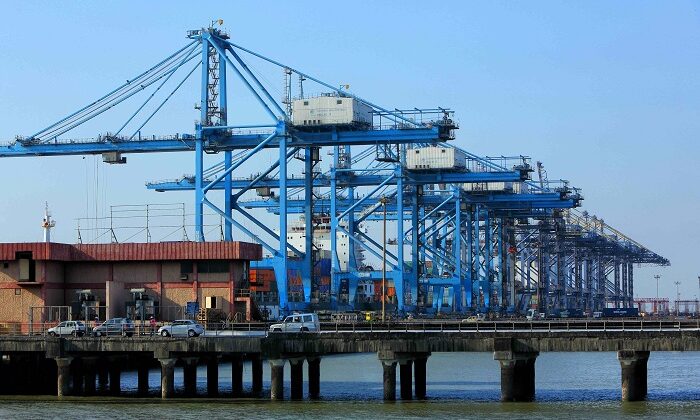
JNPT’s Multimodal Solutions for Economical Trade

MUMBAI : Multimodal transport system integrates different geographical scales from global to local by creating a transportation system composed of gateways and hubs where regional and local transportation networks converge. It results in high environmental sustainability, with the development of new modal and intermodal infrastructure and hinterlands which have gained access to the global market. A vibrant and efficient multimodal system integrates roads, rail, sea, inland waterways, air and warehousing facilities.

Jawaharlal Nehru Port Trust (JNPT)
Jawaharlal Nehru Port Trust (JNPT) has formulated a strategic model to conceptualize multimodal maritime connectivity at the regional and global level. With an extensive network of road, rail and coastal shipping, JNPT is well connected with the rest of the country. The port’s maritime and intermodal solutions create better transportation, ensure manufacturing hubs gets easy and shortest route to take their goods for exports.
Coastal berths provide an impetus for coastal cargo movement and enhance coastal shipping of goods and passengers. Better infrastructure for coastal shipping decongests rail and road networks besides ensuring cost-competitive and effective multi-modal transportation solutions. The construction of the dedicated coastal berth with a capacity of handling about 2.5 million tonnes of costal cargo, is in tune with the government’s policy to promote coastal shipping to shift freight from road to an environment-friendly and cost-effective mode of transport. It also meets a constant demand from the shipping and trade fraternity.
The road linkages connecting JNPT with the hinterland road network are NH4B, NH4, NH17, NH 3 & 8 and State Highway 54. National Highway 4B connects JNPT with Mumbai and other important cities of Maharashtra and Gujarat, mainly serving the heavy traffic of containerized vehicles to and fro JNPT. It has a length of 26.43 km and branches at km 108/800 of NH4. The port’s linkage to NH 4 provides connectivity to Pune and the southern states of India through NH 4B. State Highway number 66 links the port to National Highway number 17 provides connectivity to Goa. The state Highway 54 stretch connects Uran to Panvel and runs parallel to NH 4B. The Aamra Marg begins at km 125/800 of Sion Panvel highway (SH42) and passes through Belapur, Nerul and Ulwa and ends at km 13/900 of SH54.
To enhance the rail connectivity and enable faster movement of cargo to benefit the EXIM community, JNPT is linked with the Indian Railways through a lead line connecting the port with its serving station at Jasai, located on the Panvel – Uran branch line section of Mumbai Division, Central Railway, 9 km from the port. To enhance the rail connectivity, enabling faster movement of cargo to benefits the EXIM community, JNPT is connected with the Indian Railways through a lead line connecting the port with its serving station at Jasai, located on the Panvel – Uran branch line section of Mumbai Division, Central Railway, 9 km from the port.
The rail system at the port is operated and maintained by the Indian Railways, has 8 full-length railway lines serving the three existing container terminals. Besides these, there is 4 line intermediate holding yard between Jasai and the port. The Jasai station yard deals with all traffic between JNPT and the Indian Oil Tank farm Ltd. The 4 lines intermediate holding yard between Jasai and the port also serves to hold back and regulate traffic in the event of congestion at JNPT or Jasai yard. The Western Dedicated Freight Corridor (DFC) from Dadri to JNPT (1,504 Km) makes rail connectivity to Ports more viable due to the reduction in haulage charges. The Northern Corridor from JNPT to Ludhiana via Diva, Vasai road, Vadodara, Ratlam, Kota, Bayana, Mathura junction, Tughlaqabad and Delhi also gives access to hinterlands.
The functioning of Dwarf Containers train services at JNPT is a pivotal step towards streamlining the rail movement of EXIM cargo via double-stacked dwarf containers giving the EXIM community a competitive cost advantage by lowering hinterland logistical costs, while simultaneously enhancing rail-cargo traffic at the port. The containers also provide a 67% increase in volume when double-stacked and can carry a weight of 71 tons against 40 tons by a general container. Thus, rail movement of cargo through dwarf containers has the potential to lower the EXIM logistics costs, making Indian exports globally competitive.
Multimodal connectivity integrates the supply chains of the region further enhancing trade connectivity and benefits not only the business community but also the people of the sub-region. It has positive impacts on employment, domestic demand mobilisation, and improvises the macroeconomic situation of the country. Efficient and adequate systems of transportation, logistics, and trade-related infrastructure can assist a country’s ability to compete on a global scale.
JNPT’s multimodal connectivity contributes immensely in the Indian context of international supply chains. The extended gateways globally and locally are seamlessly connected to the port by rail, road, air, etc. guaranteeing maximum and flexible access to the hinterland creating flexibility and efficiencies among businesses, connecting the movement of people, goods and services.

